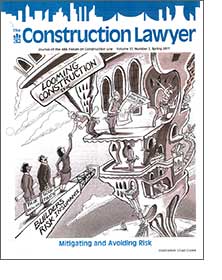 I. Introduction
I. Introduction
As Elvis Presley taught us “When things go wrong, don’t go with them.” Much can go wrong during this uncertain era of a national construction boom. One wrong move can spell financial disaster for owners, and in addition, plague end users with life-threatening, unsafe conditions. Owners can avoid these risks by implementing a strategic plan to identify what can go wrong and initiate measures to address them—before the first shovel goes into the ground. Traps exist for owners that fail to appreciate the limitations of the local labor force as well as the difficulties associated with building in congested and densely populated areas. Similar challenges arise from the failure to recognize the existence of implied warranties that arise by operation of law to benefit end users and by signing onerous contracts that wipe away valuable rights and defenses. It is foolhardy to begin the design and construction process without first considering strategic ways to (1) avoid liability; (2) mitigate liability; (3) shift liability; and (4) insure against liability.
Proactive measures can be implemented to achieve these strategic objectives. While this article will focus on specific steps an owner can take to protect its interests, these same approaches can apply to other participants to avoid and mitigate risk such as (1) establishing “single purpose” entities, (2) utilizing clauses to limit liability, (3) requiring compliance with notice and right to cure statutes, (4) conducting an early peer review to catch design errors, (5) using technology to monitor the pace of construction, and (6) initiating independent quality control inspections to mitigate the risk of faulty construction.
II. Planning Phase
A. Consider Lessons Learned and Formulate Your Best Practices
Adopting proven general strategies that have been tested and utilized successfully in the construction industry should be considered.1 Recognizing that each organization experiences its own unique issues, conducting a post-mortem project discussion to identify shortcomings and implement best practices to address these weaknesses is critical to avoiding future mistakes on other projects.
From a practical standpoint, the owner should designate a particular individual within an organization to gather, retain and communicate the lessons learned to the owner’s staff. Once a project concludes, the owner’s designee should meet with the project’s key people to discuss the following general topics: (1) what went well and why, (2) what went wrong and why, (3) what could have been done better, and (4) what could have been done to avoid problems that occurred. While it is ideal to prepare written summaries of the discussions, counsel may need to participate to shield the documentation as attorney-client privileged or increase the likelihood it is deemed work product2 so it does not become discoverable should litigation arise in the aftermath of the project.
At the outset of construction, a peer review informational session should take place with all trades to discuss how the project will be monitored from start to finish. Participants need to be placed on “high alert” that compliance with the contract documents will be expected and required. The owner needs to convey the message that the failure to follow this established process could result in financial repercussions to non-compliant participants as discussed in Section V.B. of this article.